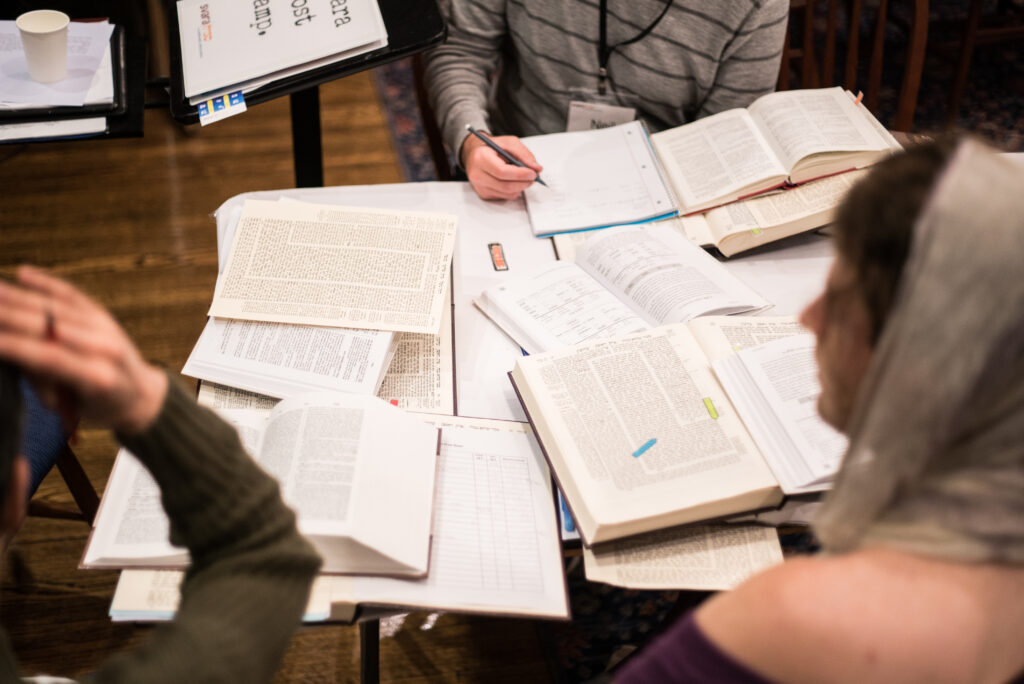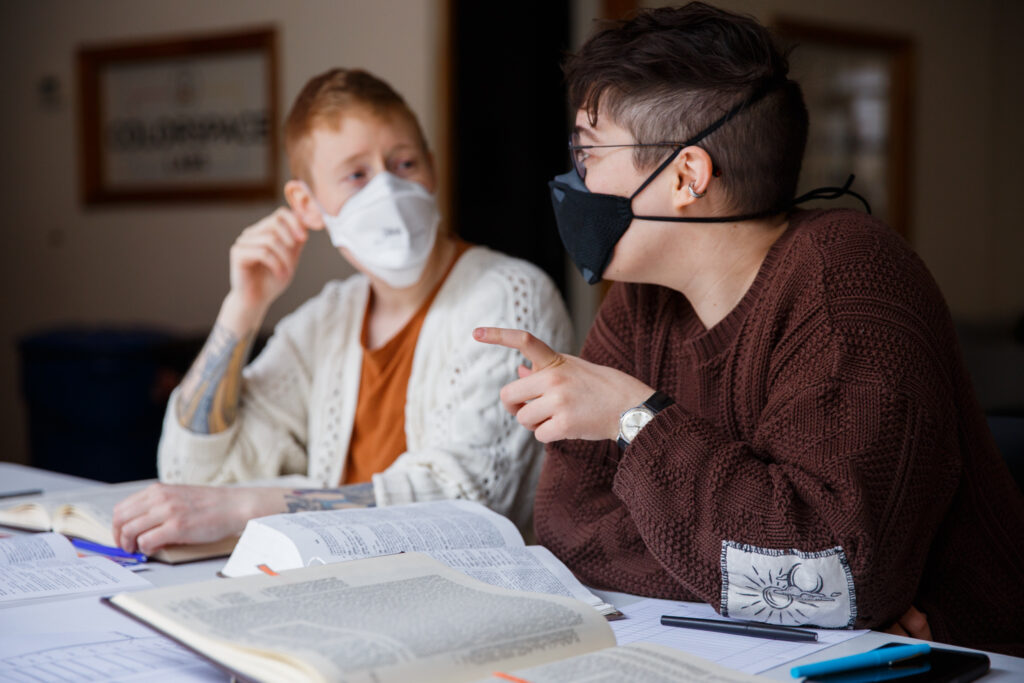“What is my lulav good for in a collapsing world?”
I asked myself this while sitting in my sukkah the other day. I could—and do—ask myself this question a lot, and I know from our learning together that many of y’all do, too. But this week it is Sukkot, and so the lulav prompted my existential inquiry. I stared at my lulav laid out on the table. It was 76 degrees in the earlier part of the day, unusually warm for the days that usually have me layering up to enjoy my favorite holiday. In fact, the chilly air is part of Sukkot’s essence in the flow of Jewish time: we’re supposed to move outside when everyone else moves inside. As R’ Yaakov ben Asher (13th century halakhist, also called the Tur after his most famous book) teaches, the Torah commands us to observe Sukkot in the fall specifically because it makes it clear to everyone around us that we’re not simply hanging out in the shade, we’re doing a weird thing for G!d! But this year, most of my neighbors have been outside. (To be fair, quite a few of my neighbors were outside in their sukkot, but some were just outside for fun.)
It’s not a mystery why Sukkot this year has been ushered in with a counter-traditional warmth. The sharp turns of seasons are surely the smallest collateral damage that we are losing to climate devastation. We know this harm is, in the language of Rabbi Julia Watts Belser, PhD, “unevenly distributed. All of us are in danger, but some of us live much closer to the storm.”
A lot of powerful and prophetic Torah has been preached about Jewish responses to climate catastrophe. I am grateful for these emerging theories and theologies and I am spiritually indebted to those who articulate these world-shaping stories that help us tell the truth of now more honestly. In a conversation earlier this year, Rabbi Elliot Kukla and Rabbi Julia Watts Belser, PhD unpacked the emergence of overwhelming grief that climate devastation is thrusting upon us in varied ways, and they both powerfully pushed back against the idea of “fixing” things. Climate devastation will not be fixed—especially on the individual level.
So, what do I do? Honestly, it’s hard not to fall into a pit of nihilism: everything is bad, it’s getting worse, and there’s no point to anything. (And the tradition of reading Kohelet—the book of the Tanakh that rings like a nihilist manifesto!—on Sukkot doesn’t really help things.)
And so, when this Sukkot I turned to the Mishnah, a familiar phrase struck me: לוּלָב הַגָּזוּל וְהַיָּבֵשׁ, פָּסוּל, lulav ha’gazul vehayaveish pasul, a stolen or dried out lulav is pasul, unfit and unacceptable (Mishnah Sukkah 3:1). The same is said for an etrog, for the roof-like schach, and for the other various parts of a sukkah: if they are stolen, they’re not kosher. The early Rabbis give us one reason why:
“ולקחתם לכם ביום הראשון”… “לכם” – משלכם, ולא את הגזול
The Torah says “You must take for yourselves [a lulav & etrog] on the first day.” “For yourselves” means that it must be from the stuff that’s yours, and therefore it should not be stolen.
We deduce from the way the verse flows that if it has to be yours, it can’t be someone else’s. The mitzvah isn’t simply to shake the lulav: it’s to get a lulav of your own, and to do all of the holy choreography that entails, as well.
But the gemara offers further explanation:
.אמר רבי יוחנן משום רבי שמעון בן יוחי: משום דהוה ליה מצוה הבאה בעבירה
.אתמר נמי, אמר רבי אמי: יבש פסול מפני שאין הדר, גזול פסול משום דהוה ליה מצוה הבאה בעבירה
Rabbi Yochanan said in the name of Rabbi Shimon bar Yochai: A stolen lulav is unfit because it is a mitzvah fulfilled through a transgression.”
This is also stated by Rabbi Ammi: “A dried out lulav is unfit because it is not distinguished; a stolen lulav is unfit because it is a mitzvah fulfilled through a transgression.”
Rabbi Shimon teaches us that a stolen lulav—along with other Sukkot accoutrements—is unfit for use is because it is a mitzvah that is done through some form of transgression, “mitzvah ha’bah be’aveira.” Here Rabbi Shimon and Rabbi Ami give voice to “mitzvah ha’bah be’aveirah,” which might be translated “inside” more precisely as “a commandment that comes through a transgression.” Rabbi Shimon and Rabbi Ami introduce this concept as a larger principle at play, teaching it into existence. Through this sugya, a handful of others, and later commentaries, mitzvah ha’bah be’aveirah comes to refer to not just this local-to-Sukkot moment, but to any instance in which something used for sacred purposes has transgressive origins.
It feels so intuitive and maybe even absurd to say—of course you can’t do a mitzvah with objects that have been stolen! Of course something that has been acquired or made or shaped with transgression is dis-pleasing to G!d…Right? Feeling the weight of the mess of our world, compounded by a warmer-than-normal season of Sukkot, I started wondering about my—and my lulav’s—proximity to an infinite number of unknown transgressions.
Creating this principle gives the Rabbis the language and framework to test the limits of this seemingly obvious religious instinct.
And test the limits they do: what counts as mitzvah ha’bah be’aveirah? In our world—and likely in theirs, too—the limits of mitzvah ha’bah be’aveira are seemingly unending. How close to my consumption must the aveira be? What if something happened long ago? But what about something that has an aveira in its past? What about something that comes from an aveira or was grown and harvested in the context of an aveira?
By the time the produce transfers hands from one who stole, then to the merchants, then to us, the objects are permitted (Sukkah 30a). This principle does not require that we excavate the seedy origins of our mitzvah objects, but insists that we create as much distance between ourselves and the act of theft as possible (in the words of the gemara, וְיַבְרִיחוּ עַצְמָן מִן הַגָּזֵל, that our people should “flee” or “hide” from robbery).
But why the lulav? Why does this core framework get attached to and extrapolated from the construction of the arba minim, and the sukkah. Why not tefillin? Or the Torah itself?
I love Sukkot. It’s delicious and delightful—the perfect conclusion to a season of restoration. As we presume to leave the world of teshuva and repair behind, we enter the world of the material: gathering supplies, building things, being with people, welcoming in our ancestors. On Yom Kippur we imagine a different world: one where the gates are open, where we are angels without need for the gashmius—the substance of the material world—where we pray all day, embodying the angelic rejection of corporeality. On Sukkot we dig, and build, and make, and gather, and move—we need stuff, and that stuff necessarily comes from harm-filled places, where aveirot are abundant. As it turns out, we haven’t left teshuva behind. The Rabbis busy themselves with the everyday dilemmas of living in a world that is a mess.
Where does the water come from that nourishes our etrogim? How does the etrog come to us? What land are our arbah minim grown on? Who stewarded that land and what is (y)our relationship to them now?
Avoiding a lulav made of stolen parts doesn’t address the aveirah that took place. It doesn’t look at the systemic exploitation necessary to make a profit, at reasons for theft, at land sovereignty and displacement. To flee from robbery, as the Talmud teaches, is not the same as eradicating theft. Whether or not I use the stolen lulav, it’s still there. By finding an alternative lulav, I haven’t solved or fixed anything.
There are no untouched, pure things. We simply cannot escape foundational harms that are present in almost everything that is created, nor can we—through individual behaviors—address the devastatingly large crises unfolding around us. But this framework from the Rabbis offers a potential path that leads me out of nihilism into action, as imperfect as it may be. Mitzvah ha’bah be’aveirah isn’t about solving anything; it’s about consciously tending to, acknowledging, and reflecting on the degrees of separation between our behaviors and the exploitation that is necessarily part of living in the world. There is a time for fixing, and there is a time to recognize what our individual actions cannot fix. I find in mitzvah ha’bah be’aveira one strategy for personal choice-making, offering us an invitation to consider and grapple with the limits of our control and influence, pushing us to make choices that habituate us towards goodness even when we know our personal choices are not systemic solutions.
In my warm and beautiful sukkah this week, my lulav reminded me of the imagination that I can let in when I acknowledge the impossibility of living without harm, celebrating and shaking that I did the best I could.







